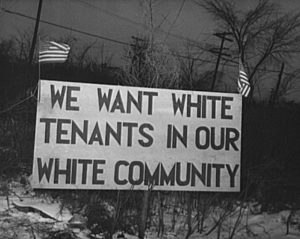
It’s been nearly fifty years since the enactment of the Fair Housing Act, but discrimination in housing remains a sobering reality of life in America. Despite the belief among some people that the first Black president has brought about an end to racism, public attitudes and practices show otherwise. A new survey found that many whites still prefer not to sell or rent to Blacks.
As was reported in The Washington Post, the General Social Survey, which has been conducted since 1973, gives whites two options. One choice says a homeowner “can decide for himself whom to sell his house to, even if he prefers not to sell it to blacks,” while the other says a homeowner “cannot refuse to sell to someone because of their race or color.” The second choice is part of Title VIII of the Civil Rights Act, also known as the Fair Housing Act, which has been the law since 1968.
In 2014, 28 percent of whites said they chose the first option, and 70 percent chose the second. In 1973, 64 percent selected the option to discriminate against Blacks, as have a majority of whites until the late 1980s.
While one can conclude this is progress, a substantial number of whites—nearly a third— still prefer to break a law that was enacted nearly half a century ago. The survey also found, for example, that 23 percent of whites would favor living in a neighborhood where half of their neighbors are Black, while 19 percent would oppose it. In 1990, 10 percent of whites favored living in a half-Black community, and 46 percent opposed.
News of the survey comes as the Obama administration introduces a new rule intended to combat housing discrimination and encourage the racial integration of communities. Announced by the Department of Housing and Urban Development (HUD), the rule will require cities and towns that receive HUD funding to track racial bias in housing and report their findings every three to five years. These communities would also set goals for reducing racial segregation.
“As a former mayor, I know firsthand that strong communities are vital to the well-being and prosperity of families,” said HUD Secretary Julián Castro in an official statement. “Unfortunately, too many Americans find their dreams limited by where they come from, and a ZIP code should never determine a child’s future. This important step will give local leaders the tools they need to provide all Americans with access to safe, affordable housing in communities that are rich with opportunity.”
The new rule would make it more difficult to break the law, and HUD is considering withholding federal funds to localities that refuse to abide by the rules. Conservative Republicans in Congress, viewing this as government intrusion and social engineering that goes against the free market and forces whites to change their neighborhoods, seek to gut funding for implementation of the rule.
Enacted in the days following the assassination of Dr. Martin Luther King, Jr., the Fair Housing Act prohibited discrimination in the sale, renting or financing of housing on the basis of race, color, religion, sex or national origin. Since then, it has been amended to prohibit discrimination based on disability or familial status, including pregnant women and families with minor children. It also increases enforcement mechanisms for the government to sue on behalf of victims in federal court. In many ways, the Fair Housing Act was the forgotten civil rights legislation, receiving far less attention than the Civil Rights Act of 1964 and the Voting Rights Act of 1965.
As Janell Ross reported in The Washington Post, George Romney—President Nixon’s HUD secretary and father of 2012 GOP presidential nominee Mitt Romney—“called the combination of federal programs that for decades had almost exclusively helped millions of white Americans buy homes in more affluent suburbs and continued segregation in cities a ‘white noose’ around the country’s Black, increasingly poor and in some cases, riot-damaged communities.
Romney wanted to withhold federal funds from communities that resisted housing desegregation, but Nixon would not let that happen. And subsequent administrations have fought over the issue. As a result, the Fair Housing Act as not been enforced, and the nation’s communities have remained deeply segregated, with relatively few Blacks and Latinos making inroads into more well-to-do, middle-income neighborhoods, and white communities remaining white. This is not simply a matter of people of color living next to white people for the sake of it. Rather, racial segregation is a source of inequality in all areas of life, including low education levels, poorer health and lower life expectancy, and higher unemployment.
As a recent Stanford University study found, “[t]o the extent that (1) segregation patterns lead to racial or socioeconomic disparities in neighborhood conditions and (2) neighborhood conditions affect opportunities and outcomes, it follows that segregation patterns may lead to racial or socioeconomic disparities in social mobility and well-being.” The study also found that racial and socioeconomic segregation go hand in hand, as the average affluent family of color lives in a more economically depressed neighborhood than a typical low-income white family.
For years, the federal government, banks, real estate agents and city housing authorities have conspired to restrict Black people to segregated housing in poor areas, with redlining policies that deny lending to Black homebuyers, and exploitative tools such as subprime mortgages, which have caused a massive loss of Black wealth and further impoverishment of communities of color.
In June, 2015, the U.S. Supreme Court upheld the Fair Housing Act in Texas Department of Housing and Community Affairs v. Inclusive Communities Project. In a 5-4 decision, the nation’s high court preserved federal measures to protect against housing discrimination. Justice Clarence Thomas provided a dissent, using the National Basketball Association as proof that “Racial imbalances do not always disfavor minorities.”
Five decades after the Fair Housing Act, at a time when issues of racial injustice and the plight of Black people are once again in the public consciousness, housing discrimination persists. It remains to be seen if the newest measures from the Obama administration will make a difference.


